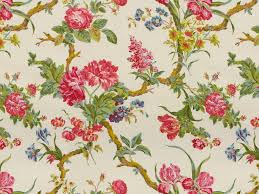chintz
英 [tʃɪnts]
美 [tʃɪnts]
- n. 印花棉布(等于chints)
- adj. 擦光印花布的
星级词汇:

记忆方法
记忆单词“chintz”的最简单方法是将它与“cheer”结合,因为这两个单词的拼写有相似之处。想象在“cheer”(欢呼)的人群中,人们穿着色彩鲜艳、图案繁复的“chintz”布料制成的衣服,这样的视觉联想可以帮助记忆这个单词的含义,即一种有特色的印花布料。
以上内容由AI生成, 仅供参考和借鉴
中文词源
chintz 轧光印花棉布
来自梵语,进一步来自PIE*skai, 照耀,发光,词源同shine, cheetah. 因这种布料的花哨而得名。
英语词源
- chintz
-
chintz: [17] Chintz is originally an Indian word. English borrowed it from Hindi chīnt, and at first used it unaltered: Samuel Pepys, for instance, writing in his diary for 5 September 1663, notes ‘Bought my wife a chint, that is, a painted Indian calico, for to line her new study’. However, since in commercial use the plural form, chints, was so much commoner than the singular, it eventually came to be regarded as a singular itself, and the s-less form dropped out of the language.
In the 18th century, for some unexplained reason (perhaps on the analogy of such words as quartz) chints began to be spelled chintz. The Hindi word itself was originally an adjective, which came from Sanskrit chitra ‘many-coloured, bright’ (ultimate source of English chit ‘small piece of paper containing some sort of official notification’ [18]).
=> chit - chintz (n.)
- 1719, plural of chint (1610s), from Hindi chint, from Sanskrit chitra-s "clear, bright" (compare cheetah). The plural (the more common form of the word in commercial use) became regarded as singular by late 18c., and for unknown reason shifted -s to -z; perhaps after quartz. Disparaging sense, from the commonness of the fabric, is first recorded 1851 in George Eliot (in chintzy).
权威例句
- 1. We shall cover the seat of this old chair with chintz.
- 我们将用印花布罩住这旧椅子的椅面.
- 2. The door gave access to a tidily furnished sitting - room where chintz and oak predominated.
- 打开这扇门后便进入一个被印花棉布和橡木装饰得非常整洁的起居室.